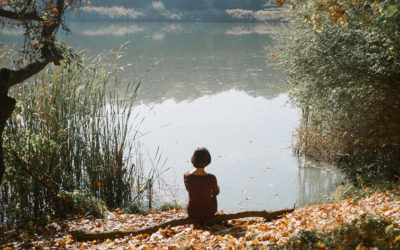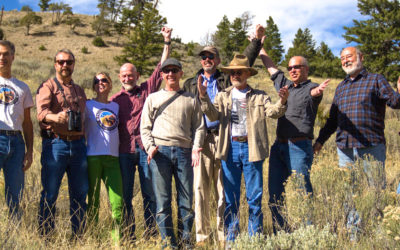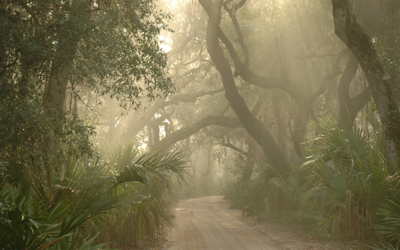Photo credit © Kevin Noble
Good News: Wilderness Is Not a Victim of Our Current Intense Political Partisanship
Stewardship
December 2020 | Volume 26, Number 3
In these times of the COVID-19 virus and lockdowns, and deepening concern by perceptive people about the crisis of our global climate, we also face terrible problems with maldistribution of wealth skewed to the very top, leaving behind the 99.9 % – with a dreadfully sharp tilt toward racial minorities at the very bottom.
We have spent trillions in feverish attempts to reignite the pandemic-shuttered economy, but the spending priorities are not broad enough to encompass land protection. All this is seemingly locked in by the intense partisanship that infests everything about our politics.
We might easily throw up our hands and bury our heads in the proverbial sand in frustration. A deeply corrosive cynicism about the ability of our political leaders to do anything about these challenges is enervating.
Caring about wilderness and other protected lands – and wishing to do something about them – is part of this bitter mix. Sadly, these are no part of our current priorities, from Washington on down.
The four agencies administering our National Wilderness Preservation System face far worse budgetary challenges than ever before. The deep gloom in the stripped-down agency offices is palpable. One may worry that you will never again see a ranger on a wilderness trail. This makes the work of local wilderness stewardship groups, fostered and trained by organizations such as the National Wilderness Stewardship Alliance, all the more important, getting trained volunteers on the job of trail maintenance and monitoring, with the aid of groups like Backcountry Horsemen of America, in packing in crosscut saws and supplies.
As for intense political partisanships, it is a fact of life in our politics and will always be. But it need not high-center progress for wilderness.
As for intense political partisanships, it is a fact of life in our politics and will always be. But it need not high-center progress for wilderness. For example, in the late 1970s, Republicans joined Democrats in the campaign to protect vast expanses of the federal land in Alaska in national parks, national wildlife refuges, wild and scenic rivers, and national monuments as units of the national park system and national forest system.
Alaska is huge – beyond a landscape anyone can ever hope to see in one lifetime, bush plane access notwithstanding. Some federal lands were set apart for protection of wildlife and park values in the years before statehood, notably the then-9-million-acre (3,642,171-ha) Arctic National Wildlife Range (Kaye 2006).
Democratic champions for Alaska were led by Representative Morris K. “Mo” Udall of Tucson, Arizona, chair of the Committee on Interior and Insular Affairs and lead sponsor of the legislation in the US House of Representatives (Carson and Johnson 2001). He was ably abetted by Representatives John F. Seiberling, of Akron, Ohio, chair of the Subcommittee on General Oversight and Alaska Lands who became personally expert about every area in the proposed legislation (Nelson 2009). Representative Phillip Burton of San Francisco, chair of the Subcommittee on Parks and Insular Affairs was powerful beyond his subcommittee’s work and put his shoulder to wheel on every park, river, and wilderness protection measure of the era (Jacobs 1995). These leaders were staffed by amazingly talented women and men, and abetted by the far-flung lobbying, media, and grassroots work of the national environmental movement, with every group contributing people, membership lists, and money into a single operation for the only time in their history: the Alaska Coalition. In the era before e-mail, the combined mailing list reached more than 1 million conservation-minded Americans – and we mailed alerts to them first class.
For the only time in the history of the wilderness and environmental movement, money was no object.
The lobbying was intense, but conservationists had a key player in their corner from the start—the president of the United States. President Jimmy Carter made this a top priority and assigned a member of his White House lobbying team to the campaign full-time.
Republicans, in particular Representative John Anderson of Rockford, Illinois; Representative Thomas B. Evans of Delaware; Representative Millicent H. Fenwick of New Jersey; and others joined Democrats to give us success in enacting the huge land designation package – the Alaska National Interest Lands Conservation Act.
The law was signed by President Jimmy Carter on December 2, 1980.
After they left the White House, the Carters visited the threatened Coastal Plain of the Arctic National Wildlife Refuge. In an opinion column published by the Los Angeles Times, President Carter remembered, “During my four years as President, I approved hundreds of bills. But one that gave me particular satisfaction was the Alaska Lands Act…. It was one of the great conservation laws of all time, protecting more than 100 million acres in our extraordinary 49th state” (Carter 1990).
Although some Alaskans were angered by this land protection, the law provided virtually unlimited subsistence hunting and fishing rights on the federal lands, based on where people live and not limited to Alaska Natives, as was the case previously. (Of course, sport hunting remains off-limits in all national parks.)
Perhaps surprisingly, progress for protecting wild federal lands in Alaska continued, always involving significant leveraging and compromise with the Republican congressional delegation. Another five wilderness areas totaling 250,000 acres (101,171 ha) were designated as part of the Tongass Timber Reform Act in 1990, which pulled back significantly on the kind of huge, ruinous clear-cuts that had been practiced on the Tongass National Forest in southeast Alaska for decades (Tongass Timber Supply Act 1990). This is a good reminder that progress for land and water protection is often propelled by the excesses of development interests.
Similarly, the California Desert Protection Act of 1994 was a thoroughly bipartisan success, championed by Senator Diane Feinstein and Representative Richard Lehman, both of California, but also nine Republican members of the House of Representatives – although none from California. This law established Death Valley and Joshua Tree National Parks and the Mojave National Preserve (which allows hunting) and designated 69 wilderness areas protecting some 7,661,089 acres (3,100,333 ha).
The best example of deep bipartisanship is the Wilderness Act of 1964 itself. Its lead sponsors were not only Democrats such as Senator James Murray of Montana and Senator Clinton P. Anderson of New Mexico (who, as a young civic leader in Albuquerque, was a friend of wilderness pioneer Aldo Leopold) (Baker 1985). Senator Frank Church, also a Democrat, led the floor debate on behalf of the Wilderness Bill in 1961 and, after the bill failed in the US House of Representatives, again in 1963 (Ashby and Gramer 1994). The great Republican preservation champion, Representative John P. Saylor of Johnstown, Pennsylvania. was invaluable in the lead for the Wilderness Bill from his first introduction of it in the US House of Representatives in June 1956 through the many laws designating the first additions, where it was vital to assure that the precedents being set were exactly as needed for the success of the whole wilderness preservation endeavor in the future (Smith 2006).
Saylor also played a key role in blocking dam-building threats to protected land, notably the backcountry of Dinosaur National Monument at a place called Echo Park on the Utah-Colorado border. This win broke the back of the dam-building movement once and for all and was the vital platform deliberately built by Howard Zahniser, executive director of The Wilderness Society (Harvey 2005). He and David Brower, the executive director of the Sierra Club, were the perfect team and understood that success in blocking the dam would be key to launching the Wilderness Act, which otherwise would have been a nearly hopeless proposition in that era (Harvey 1990). We called Saylor “St. John” behind his back – which he loved.
The Wilderness Bill had been long stalled in the House of Representatives by demands of the crusty committee chairman, Wayne N. Aspinall, who represented the entire West Slope of Colorado, dependent on water stored behind dams on the Upper Colorado River. He wanted assurances both about water rights and a period for new mining claims in national forest “primitive areas.” It is not widely known that Representative John D. Dingell, a very powerful member, was a key player in reaching an accommodation with Chairman Aspinall – a capitulation to his demands, really – thus allowing final action by the House of Representatives to send the Wilderness Bill to the Senate in 1963 (Schulte 2002).
The Wilderness Act was avidly sought by President John F. Kennedy and his secretary of the interior, Stewart Udall, then by President Lyndon B. Johnson – and by every subsequent president regardless of political party. Later, President Richard M. Nixon signed many wilderness designation laws, thanks to the influence of his top domestic adviser, John Ehrlichman (later of Watergate fame), who was avidly devoted to land protection and urged the president to sign these laws, in which he had no particular interest.
President Ronald Reagan signed more wilderness designation laws than any other president. He was actually signing roadless area release laws, but with ample wilderness designations attached to make them legislatively viable – while President Jimmy Carter signed by far the largest acreage, and not solely because of the huge acreage in the Alaska National Interest Lands Conservation Act (Turner 2012).
Secretary of the Interior Cecil Andrus, the former governor of Idaho, took President and Mrs. Carter and First Daughter Amy on a float trip down the Middle Fork of the Salmon River in the newly designated Frank Church-River of No Return Wilderness Area in Idaho in 1978.
As the Washington Post reported, “There were no handshakes, dignitaries to greet or protocol observed as the president, his family and a few friends floated gently down the Middle Fork of the Salmon River here.” Imagine the Secret Service behind every tree and boulder. But the Post added, “Security, while thorough, was low-keyed. Reporters, though on the river with him, were kept miles behind except for one or two token contacts with the presidential party” (Barbash 1978). The president was proud of having signed this law.
The latest lesson in bipartisanship is the John D. Dingell Conservation, Management, and Conservation Act of 2019, which became law when signed by President Donald J. Trump on March 12, 2019.
This law expanded several national parks and other areas of the national park system and established four new national monuments while redesignating others. It also designated more than 3,158,038 acres (1,278,913 ha) of wilderness areas, protected additional segments of wild and scenic rivers and historic sites, and withdrew land near Yellowstone National Park and North Cascades National Park from mining (Eilperin and Grandoni 2019).
The significance of the bipartisan support for this huge package law is not to be missed. It contained so many provisions, each strongly backed by the local congressional delegation, that it was carried through Congress relatively quickly on a bipartisan wave, led by Senator Lisa Murkowski of Alaska, the chair of the US Senate Committee on Energy and Natural Resources. The lead cosponsor was the ranking Democrat on the committee, Senator Maria Cantwell of Washington State.
Other provisions included a long-desired provision permanently authorizing the Land and Water Conservation Fund, thus allowing appropriators to simply fund it from year to year. This includes a specific line-item within the Omnibus Appropriations Bill for FY2020 that was passed and signed into law in late December.
The US Forest Service requested $3,500,000 for the critical “inholdings”/wilderness line, and they also received $8,000,000 for acquisition management. The Bureau of Land Management received a substantial bump for inholdings to $3,500,000. This increased funding is vital to the ongoing work of The Wilderness Land Trust, a nonprofit organization that negotiates win-win deals with landowners to acquire these lands, working from priorities for each state set with the land management agencies, primarily the US Forest Service and Bureau of Land Management.
Not all this money comes to The Wilderness Land Trust and other nonprofit organization, but the funds we can count on help to leverage donations, grants, and loans to support our work at a robust level. Funding is out there, and with shifting priorities and public support, maybe money can once again not be an object for wilderness protection.
And there is always more to do for our public lands. We need more money to support programs for getting kids out into parks and other green places – the kind of childhood experiences most of us took for granted. This is especially missing in our inner cities. We also need many more initiatives to engage and deploy our public workforce, such as a new Civilian Conservation Corps.
Through all my years as an advocate for wilderness preservation, I know none of these things are easy. But we have tremendous supporters today in Congress and state legislatures – of both parties. So, as I stated at the beginning of this article, there is good news. Wilderness is not a victim of political partnership. And it may yet continue to be a bridge to bipartisanship, consensus, and cooperation.
About the Authors
DOUG SCOTT spent decades as a lobbyist for The Wilderness Society, the Sierra Club, and the Pew Charitable Trusts, working to gain congressional protection for national parks, national wildlife refuges, wild and scenic rivers, and wilderness areas. He singles out the Alaska National Interest Lands Conservation Act of 1980 as a career highlight. Doug’s most recent anthology is Wild Thoughts: Short Selections by Great Writers About Nature, Wilderness, and the People Who Protect Them will be published in 2021.
References
Ashby L,. and R. Gramer. 1994. Fighting the Odds: The Life of Senator Frank Church. Pullman: Washington State University Press.
Baker, R. A. 1985. Conservation Politics: The Senate Career of Clinton P. Anderson. Albuquerque: University of New Mexico Press.
Barbash, F. 1978. Carters find peace, quiet in Idaho wilderness. Washington Post, August 24, 1978,
Carson, D. W., and J. W. Johnson. 2001. Mo: The Life and Times of Morris K. Udall. Tucson: University of Arizona Press.
Carter, J. 1990. A Tundra Industrial Complex? No! Los Angeles Times, November 30, 1990.
Eilperin, J., and D. Grandoni. 2019. The Senate just passed the decade’s biggest public lands package. Here’s what’s in it. Washington Post, https://www.washingtonpost.com/climate-environment/2019/02/12/senate-just-passed-decades-biggest-public-lands-package-heres-whats-it/
Harvey, M. 2005. Wilderness Forever: Howard Zahniser and the Path to the Wilderness Act. Seattle: University of Washington Press.
Harvey, M. W. T. 1990. A Symbol of Wilderness: Echo Park and the American Conservation Movement. Albuquerque: University of New Mexico Press.
H.R. 518, 103rd Congress. Congress.gov.
Jacobs, J. 1995. A Rage for Justice: The Passion and Politics of Phillip Burton. Berkeley: University of California Press.
Kaye, R. 2006. The Last Wilderness: The Campaign to Establish the Arctic National Wildlife Refuge. Fairbanks: University of Alaska Press.
Nelson, D. 2009. A Passion for the Land: John F. Seiberling and the Environmental Movement. Kent, OH: Kent State University Press.
Schulte, S. C. 2002. Wayne Aspinall and the Shaping of the American West. Boulder: University Press of Colorado.
Smith, T. G. 2006. Green Republican: John Saylor and the Preservation of America’s Wilderness. Pittsburgh: University of Pittsburgh Press.
Tongass Timber Supply Act, Public Law 1010–626, November 28, 1990.
Turner, J. M. 2012. The Promise of Wilderness: American Environmental Politics Since 1964. Seattle: University of Washington Press.
Wheat, F. 1999. California Desert Miracle: The Fight for the Desert Parks and Wilderness. San Diego: Sunbelt Publications, Inc.
Read Next
What We Have and What We Need
As we reach the end of the 26th volume of the International Journal of Wilderness, it is worthwhile to reflect on this year that was 2020.
A Tribute to Michael Soulé
The following is a tribute to the life and contributions of Michael Soulé from several colleagues and friends.
The Preservation Paradox: How to Manage Cultural Resources in Wilderness? An Example from the National Park Service
At the same time that federal agencies must comply with protection measures of the Wilderness Act, federal cultural resource laws require agencies to take into account the effects of federal undertakings on cultural resources.



